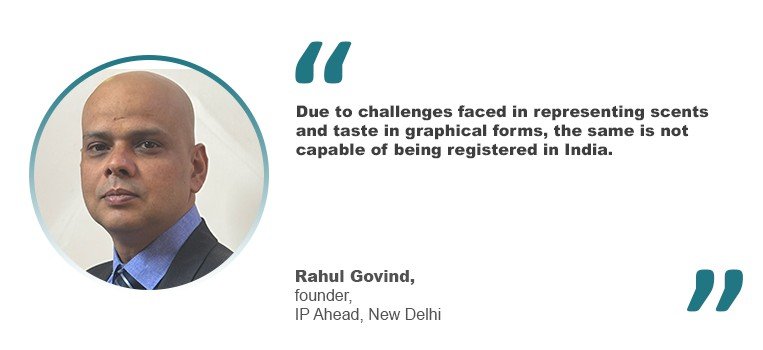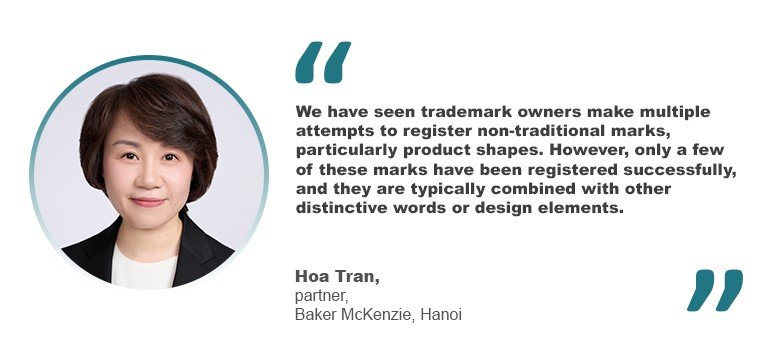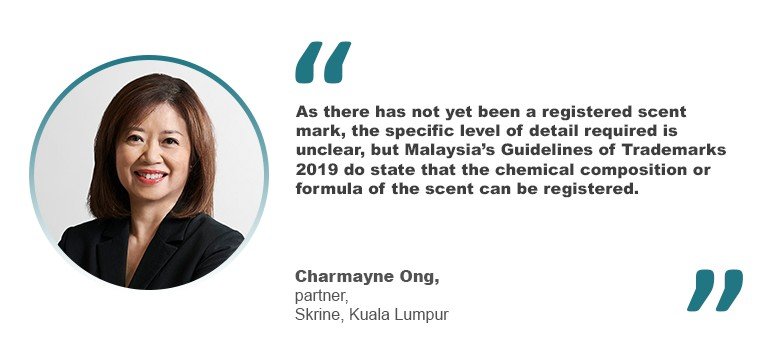The unconventionalities of non-traditional marks
31 May 2025

What makes a scent or sound legally yours? Espie Angelica A. de Leon explores how brands navigate strict rules and push creative and legal boundaries to protect the intangible.
Metro Goldwyn Mayer’s lion’s roar, the shape of a Pepsi bottle, Christian Louboutin’s red sole heel colour, Nokia’s boot-up sound, the scent of Play-Doh – what do they all have in common?
They are trademarks of globally successful brands. They are unique and therefore distinctive. They are also registered. These marks are called non-traditional trademarks.
Non-traditional trademarks are non-conventional marks that are identifying features of a brand just as much as the company’s brand name or logo. Examples of such trademarks are colours, shapes, sounds, tastes, scents or smells as exemplified above.
In certain jurisdictions, however, some of these non-conventional marks cannot be registered.
In Malaysia, for example, taste marks are not expressly covered by the Trademarks Act, 2019.
“Based on our searches on the online register maintained by the Intellectual Property Corporation of Malaysia, there have been a lot of trademark applications filed for non-traditional trademarks, and the most common seem to be applications for shape marks. However, only 38 have been successfully registered thus far. There do not seem to have been any colour or scent marks granted registration yet in Malaysia,” said Charmayne Ong, a partner at Skrine in Kuala Lumpur.

In addition to taste marks, scents aren’t registrable as well in India and Vietnam.
“Due to challenges faced in representing scents and taste in graphical forms, the same is not capable of being registered in India,” explained Rahul Govind, founder and principal at IP Ahead in New Delhi.
Other non-traditional trademarks are finding their way into applications filed at India’s IP office. A good number of them have already been granted trademark protection. “There have been a number of successful registrations for colour or a combination of colours, sound and shape of goods in India. For example, the Webex sound mark, the Mastercard acceptance tone, Christian Louboutin’s red sole colour mark and the Victorinox colour mark,” Govind related.
In Vietnam, very few non-traditional marks are actually accepted for registration. According to Hoa Tran, partner and head of trademarks at Baker McKenzie in Hanoi, Vietnam’s IP office tends to be stringent in examining these non-conventional marks.

“We have seen trademark owners make multiple attempts to register non-traditional marks, particularly product shapes. However, only a few of these marks have been registered successfully, and they are typically combined with other distinctive words or design elements. Additionally, applications for sound marks have been few, and to date, no sound marks have been granted registration,” Tran related.
She expressed her belief that shapes, colours, sounds, tastes and scents along with other non-conventional marks must be protected as long as they are recognizable to consumers.
Tran said their registration as trademarks will effectively distinguish their goods and services from others in the market – but she emphasized that the protection of such trademarks should be compatible with the evolving business landscape and legal developments. “In particular, recognition of non-traditional marks must align with the development of legal frameworks that allow for these rights to be enforced. If marks can be registered but not enforced,” she noted, “they would have little value in protecting a business.”
In contrast, Singapore allows the registration of taste and smell marks, aside from other non-conventional trademarks, provided they are distinctive, of course.
As of April 2025, about 1,560 applications for three-dimensional shape trademarks had been filed out of nearly 2,439 non-traditional trademark applications filed with the Intellectual Property Office of Singapore (IPOS) overall. Three-dimensional marks remain the most commonly filed type of non-conventional trademark.
One such registration is that of the 3D shape of a pen in Singapore. “Despite the wide variety of pens available in the market, the three-dimensional shapes of writing instruments, such as a pen by Zebra, have successfully been registered as trademarks in Singapore. This indicates that the specific shape of these pens has met the criteria for trademark registration, including being distinctive and not confusingly similar to other existing pen shapes in the market,” said Sanil Khatri, local principal at Baker McKenzie Wong & Leow in Singapore.
Colour marks filed with IPOS numbered around 357. Some sound marks have also been registered in Singapore, including the sound mark by Marriott International.
Challenges
The graphical representation requirement and proof of distinctiveness
A major roadblock in the registration of a non-conventional trademark is how to show its distinctiveness. Related to this is the requirement for a graphical representation of the mark which is particularly problematic for smell, sound and taste marks.
“For example, an invented lemongrass scent must be clearly differentiated from other similar scents. The degree of differentiation between the applicant’s scent and the original scent must be significant to meet the criteria for registration. This ensures that the scent mark is unique and not easily confused with other scents,” Khatri explained.

The same goes for taste marks. A detailed written description of the taste mark will serve as a graphical representation. However, tastes may vary based on individual taste sensations. The taste may also be influenced by various factors such as age, food preferences, consumption habits and the environment in which the product is consumed. “It is challenging for taste marks to function as trademarks because consumers do not have access to the product’s flavour before purchase. This is particularly problematic for medicinal goods, where taste testing is unlikely,” noted Khatri.
Tran added new evidence, such as consumer surveys proving a mark’s distinctiveness, is often not accepted. “This makes it difficult to overcome initial refusals and demonstrate that unconventional marks are inherently distinctive,” she said.
Conservative examination viewpoints
According to Tran, examiners often have conservative viewpoints. To them, shapes and colours are usually indistinctive, unless these are combined with other distinctive elements. In Vietnam, single colours or simple combinations are rarely accepted.
Unclear regulations and vague examination criteria
Making it even more difficult is the lack of detailed guidance for examining unconventional marks. This leads to inconsistency of examiners’ views which, in turn, creates uncertainty and difficulty in predicting the outcomes of trademark applications.
Technological and expertise gaps
“There is a gap between the technology and the expertise needed to analyze and examine sound trademarks. No guidance has been issued for examining sound marks, which delays the implementation of sound trademark provisions under the latest IP regulations,” Tran explained.
In Malaysia, registering shape marks faces challenges in that the Trademarks Act 2019 prohibits registration of the following: shapes which result from the nature of the goods themselves, shapes which are necessary to obtain a technical result, and shapes which give substantial value to the goods.
How to overcome these challenges
Make your trademark as distinctive as possible. Avoid shape and colour marks that are basic and common. Instead, invest time and be creative when designing your trademark.
“During the process, it is advisable to add devices, designs and stylization – among other features – to increase the distinctiveness of the desired mark. If the mark involves a 3D mark, it is best to provide various visual views of the mark with a clear description. For sound marks, additional details such as the description, musical notation and a clear audio file should be submitted,” said Khatri.
“To show distinctiveness, trademark owners and lawyers could also try relying on factual distinctiveness acquired through use if their trademark is well-known or well-used in Malaysia. The mark must, through use, acquire secondary meaning and become associated by consumers and traders with the applicant and/or its goods or services, thus distinguishing them from other goods or services of a similar nature,” Ong added. “Evidence demonstrating this should be submitted where permitted, such as promotional materials, market share, market surveys and the like.”

Give clear and precise descriptions of the mark in your application. According to Ong, this applies especially to scent and sound marks since both are not capable of graphical representation. She revealed that Malaysia’s Guidelines of Trademarks 2019 appear to exempt scent marks from the graphical representation requirement. Instead, a clear, detailed and precise description of the scent is required. “As there has not yet been a registered scent mark, the specific level of detail required is unclear, but the guidelines do state that the chemical composition or formula of the scent can be sent and also provide the following as an example of a description: ‘The trademark is a scent mark. It consists of the smell of freshly cut grass for tennis balls,’” Ong said.
The guidelines also indicate that applicants for sound mark registration should submit a recording of the sound in MP3 format. A graphical representation of the mark’s musical notation may also be provided.
Provide comprehensive supporting evidence. To prove your mark’s distinctiveness, include consumer surveys, market research, market share, promotional materials and examples of successful registrations in other jurisdictions. “These can help overcome conservative viewpoints and demonstrate the mark’s uniqueness,” said Tran.
Register your mark after using it in the market for two to three years. “If any application is filed with prior use of the mark, the trademark owners and lawyers can argue acquired distinctiveness of the mark and its recognition in the market,” said Govind.
Invest in good marketing strategies. Having good marketing strategies, such as advertisements and campaigns, will ensure that the non-traditional mark can serve as a source identifier on its own.
Use technological solutions. “Advocate for the adoption of technological solutions and expertise to analyze and examine unconventional marks, especially sound trademarks. Collaborate with other IP offices to share knowledge and technology,” said Tran.
Seek advice from a trademark lawyer. Get advice on the registrability of a mark based on the results of prior searches and whether it is considered distinctive to the public in general.
“For example, if an applicant intends to register a bottle shaped like an apple, this shape may be perceived as natural and therefore difficult to prove as unique by a proprietor,” Khatri pointed out.
Adopt international best practices. The U.S., Japan and EU member states have established legal frameworks for non-traditional trademarks with detailed guidelines and successful case studies. Other jurisdictions should study these best practices and adopt them.
Explore alternative protection strategies. Opt for copyright or industrial designs. These alternatives will provide protection for your mark for the meantime as the IP world waits for trademark regulations to evolve.
Other non-traditional trademarks include holograms, position marks and motion or movement or sequence of motion marks. A position mark is one whose placement on the product, size or proportion has acquired distinctiveness. One example is Levi’s stitched design on the back pocket of its famous jeans.
Meanwhile, motion or movement marks consist of moving elements such as the moving lamp featured at the start of Pixar movies.






